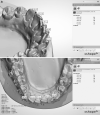Effect of low-level laser therapy on the time needed for leveling and alignment of mandibular anterior crowding
- PMID: 35344012
- PMCID: PMC9235377
- DOI: 10.2319/102721-795.1
Effect of low-level laser therapy on the time needed for leveling and alignment of mandibular anterior crowding
Abstract
Objectives: To assess the effect of low-level laser therapy (LLLT) on overall leveling and alignment time of mandibular anterior crowding and associated pain after initial archwire placement.
Materials and methods: Thirty-two females (18-25 years) with mandibular anterior crowding were randomly allocated into laser and control groups. Eligibility criteria included Angle Class I molar relationship and Little's irregularity index (LII) from 4 to 10 mm. Randomization was accomplished with a computer-generated random list. A 0.014-inch copper-nickel-titanium (Cu-NiTi) wire was inserted immediately after bonding of 0.022-inch Roth brackets followed by 0.016-inch Cu-NiTi, 0.016 × 0.022-inch NiTi then 0.017 × 0.025-inch stainless steel wire after completion of alignment. In-Ga-As laser was applied to the mandibular anterior segment in the laser group on days 3, 7, and 14, then at 1 month followed by every 2 weeks until completion of leveling and alignment. Visual analogue scale questionnaires were completed by each patient over 7 days from initial archwire placement. Digital models were used to monitor changes in the irregularity index. Blinding was applicable for outcome assessors only.
Results: The mean time for leveling and alignment was significantly lower in the laser compared to the control group (68.2 ± 28.7 and 109.5 ± 34.7 days, respectively). The laser group displayed a significantly higher mean alignment improvement percentage as well as lower pain scores compared to the control group.
Conclusions: Within the constraints of the current study, LLLT has a potential for acceleration of anterior segment alignment as well as reduction of the pain associated with placement of initial archwires.
Keywords: Acceleration; Alignment; Irregularity index; LLLT; Pain; Tooth movement.
© 2022 by The EH Angle Education and Research Foundation, Inc.
Figures
Similar articles
-
Effectiveness of tubular coaxial nickel-titanium and copper nickel-titanium orthodontic aligning archwires: A randomized clinical trial.Int Orthod. 2023 Dec;21(4):100812. doi: 10.1016/j.ortho.2023.100812. Epub 2023 Sep 28. Int Orthod. 2023. PMID: 37776695 Clinical Trial.
-
A randomized clinical trial investigating pain associated with superelastic nickel-titanium and multistranded stainless steel archwires during the initial leveling and aligning phase of orthodontic treatment.J Orthod. 2013 Dec;40(4):276-85. doi: 10.1179/1465313313Y.0000000072. J Orthod. 2013. PMID: 24297959 Free PMC article. Clinical Trial.
-
Low-level laser therapy effectiveness in accelerating orthodontic tooth movement: A randomized controlled clinical trial.Angle Orthod. 2017 Jul;87(4):499-504. doi: 10.2319/062716-503.1. Epub 2016 Nov 21. Angle Orthod. 2017. PMID: 27869476 Free PMC article. Clinical Trial.
-
A comparative assessment of clinical efficiency between premium heat-activated copper nickel-titanium and superelastic nickel-titanium archwires during initial orthodontic alignment in adolescents: a randomized clinical trial.Prog Orthod. 2019 Dec 16;20(1):46. doi: 10.1186/s40510-019-0299-4. Prog Orthod. 2019. PMID: 31840204 Free PMC article. Clinical Trial.
-
A clinical comparison of three aligning archwires in terms of alignment efficiency: A prospective clinical trial.Angle Orthod. 2015 May;85(3):434-9. doi: 10.2319/041414-274.1. Epub 2014 Aug 4. Angle Orthod. 2015. PMID: 25090135 Free PMC article. Clinical Trial.
Cited by
-
Evaluation of the Effect of Low-level Laser Therapy on Leveling Mandibular Anterior Crowding.Turk J Orthod. 2025 Mar 27;38(1):49-55. doi: 10.4274/TurkJOrthod.2024.2024.41. Turk J Orthod. 2025. PMID: 40150884 Free PMC article.
-
Influence of orthodontic archwire (nickel-titanium versus copper-nickel-titanium) on pain in adult patients in the aligning phase of treatment with self-ligating brackets (two months of follow-up): a prospective observational pilot study.Head Face Med. 2025 Feb 25;21(1):9. doi: 10.1186/s13005-025-00483-z. Head Face Med. 2025. PMID: 39994811 Free PMC article.
-
Effectiveness of Surgical and Non-Surgical Techniques for Accelerating Orthodontic Tooth Movement in Fixed Appliances and Aligners: A Systematic Review.Turk J Orthod. 2025 Mar 27;38(1):64-79. doi: 10.4274/TurkJOrthod.2025.2024.102. Turk J Orthod. 2025. PMID: 40150886 Free PMC article.
-
Efficiency of photobiomodulation on accelerating the tooth movement in the alignment phase of orthodontic treatment-A systematic review and meta-analysis.Heliyon. 2023 Jan 24;9(2):e13220. doi: 10.1016/j.heliyon.2023.e13220. eCollection 2023 Feb. Heliyon. 2023. PMID: 36798780 Free PMC article.
-
Effect of low-intensity pulsed ultrasound on the duration of mandibular anterior crowding correction and pain perception in adults undergoing orthodontic treatment: a single-blinded randomized control trial.Dental Press J Orthod. 2025 Apr 7;30(1):e2524158. doi: 10.1590/2177-6709.30.1.e2524158.oar. eCollection 2025. Dental Press J Orthod. 2025. PMID: 40197943 Free PMC article. Clinical Trial.
References
-
- Yi J, Xiao J, Li H, Li Y, Li X, Zhao Z. Effectiveness of adjunctive interventions for accelerating orthodontic tooth movement: a systematic review of systematic reviews. J Oral Rehabil . 2017;44(8):636–654. - PubMed
-
- Gravina MA, Brunharo IH, Fraga MR, et al. Clinical evaluation of dental alignment and leveling with three different types of orthodontic wires. Dental Press J Orthod . 2013;18(6):31–37. - PubMed
-
- Proffit WR, Fields HW, Jr, Moray LJ. Prevalence of malocclusion and orthodontic treatment need in the United States: estimates from the NHANES III survey. Int J Adult Orthodon Orthognath Surg . 1998;13(2):97–106. - PubMed
-
- Gibreal O, Hajeer MY, Brad B. Efficacy of piezocision-based flapless corticotomy in the orthodontic correction of severely crowded lower anterior teeth: a randomized controlled trial. Eur J Orthod . 2019;41(2):188–195. - PubMed
Publication types
MeSH terms
Substances
LinkOut - more resources
Full Text Sources
Medical
Research Materials




